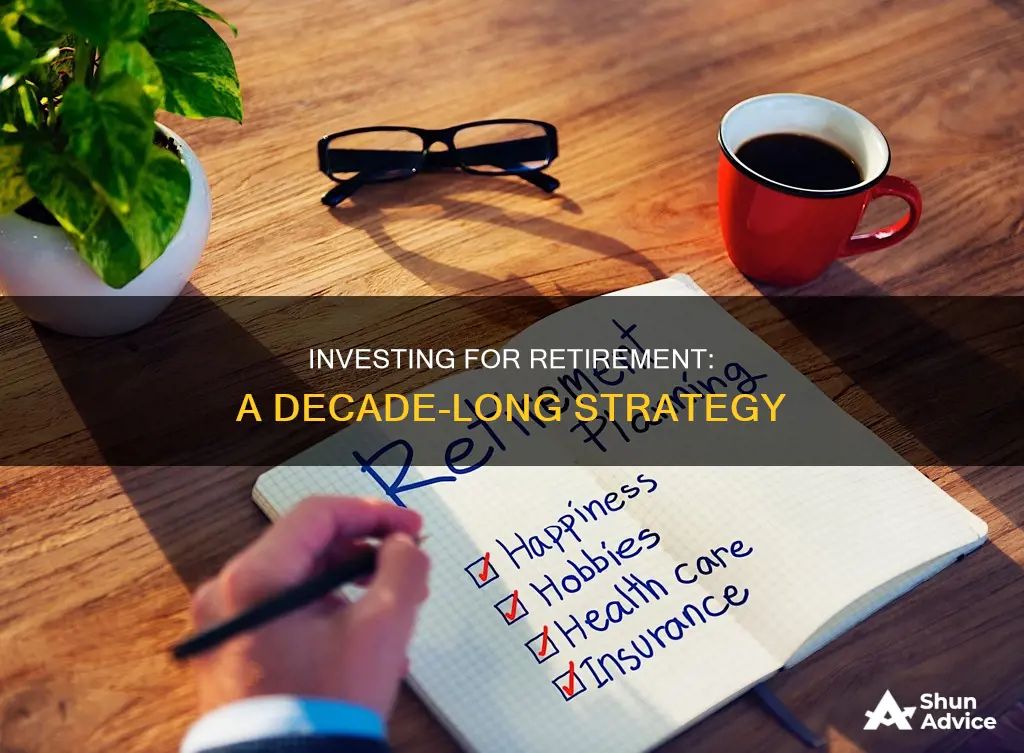
If you're 10 years away from retirement, you still have time to tuck some money away. It's important to assess your current situation, identify sources of income, and consider your retirement goals. You should also set a target retirement age and consult a financial advisor.
To increase your savings, you can increase your 401(k) and IRA contributions and set up automatic payroll deductions to savings accounts. It's also crucial to spend less and eliminate debt, especially high-interest debt such as credit cards.
Additionally, you should double-check that your savings are on track to reach your goal and decide what age you want to start claiming Social Security benefits. Budgeting for major expenses like healthcare and long-term care is also essential.
Remember, it's never too late to start investing in your future, but it will take discipline and commitment.
| Characteristics | Values |
|---|---|
| Time before retirement | 10 years |
| Current situation | Assess your current situation and identify sources of income |
| Retirement goals | Consider your retirement goals and set a target retirement age |
| Shortfall | Confront any shortfall and assess your risk tolerance |
| Consult a financial advisor | Consult a financial advisor |
| Savings | Increase savings and reduce expenses |
| Income | Identify sources of income and consider any additional income |
| Budget | Develop a monthly budget and plan for any major expenses |
| Social Security | Decide when to start claiming Social Security benefits |
| Debt | Get out of debt, especially high-interest debt |
| Investments | Take advantage of catch-up contributions and maximise investment opportunities |
| Estate planning | Put a will, trust, or estate plan in place |
What You'll Learn

Assess your current situation and sources of income
The first step to creating a 10-year retirement plan is to assess your current financial situation and sources of income. This involves taking an honest look at your income, expenses, assets, and liabilities to determine your overall financial health. Here are the steps to help you get started:
- Determine your net worth: Prepare a net worth statement by listing your financial assets (what you own) and liabilities (what you owe). This will help you understand your financial situation and make informed decisions.
- List your sources of income: Identify all your sources of income, including salary, investments, rental income, or any other sources. This will help you understand where your money is coming from and how much you can allocate towards retirement savings.
- Calculate your current retirement savings: Check the current value of your retirement accounts, such as 401(k) plans, IRAs, and pensions. These accounts are typically tax-advantaged and will provide the majority of your monthly income during retirement.
- Identify other investments and assets: Besides retirement accounts, list any other investments or assets you have, such as stocks, bonds, mutual funds, real estate, or personal property. These can also contribute to your financial goals during retirement.
- Evaluate your expenses: Review your monthly or annual expenses, including housing, utilities, transportation, food, and entertainment. Understanding your spending habits will help you identify areas where you can cut back and redirect funds towards retirement savings.
- Consider your financial goals: Define your short-term and long-term financial goals, such as saving for a down payment on a house or funding your children's education. Prioritizing these goals will help guide your retirement planning journey.
- Seek professional help: Consider consulting a financial advisor or planner, especially if your financial situation is complex. They can provide personalized advice and strategies to help you achieve your retirement goals.
Remember, assessing your current situation and sources of income is crucial for creating a realistic and effective retirement plan. It is important to be conservative in your estimates and seek professional guidance when needed. By taking the time to understand your financial landscape, you can make informed decisions and develop a comprehensive plan for the next 10 years leading up to your retirement.
UPRO: Why Investors Are Not Buying
You may want to see also

Plan for major expenses like healthcare and long-term care
Planning for healthcare and long-term care expenses is crucial when preparing for retirement. Here are some detailed steps to help you plan for these major expenses:
Understand the Costs:
Start by researching the potential costs of healthcare and long-term care. Consider factors such as your age, health status, retirement age, life expectancy, and the average cost of healthcare and long-term care services in your area.
Assess Your Current Situation:
Take an honest look at your current financial situation. Calculate your existing retirement savings, expected income sources, and monthly expenses during retirement. This will help you identify any gaps between your current savings and the amount needed to cover healthcare and long-term care expenses.
Consider Insurance Options:
Long-term care insurance can provide financial protection in case you need assistance with daily activities. Shop around and compare policies, as costs and benefits vary. Consider the type of care you may need, the duration of coverage, and whether you prefer a traditional policy or a hybrid policy that combines life insurance and long-term care coverage.
Evaluate Government Programs:
Research government programs that can provide assistance with healthcare and long-term care costs. For example, Medicare covers some medical expenses for individuals over 65 or with certain disabilities, while Medicaid offers coverage for low-income individuals. Additionally, look into programs like the Program of All-Inclusive Care for the Elderly (PACE) and the State Health Insurance Assistance Program (SHIP).
Plan for Out-of-Pocket Expenses:
If you choose to self-fund your long-term care, ensure your retirement plan can withstand these expenses. Consider the impact on your retirement savings and other financial goals. Also, evaluate the potential tax ramifications of using qualified retirement accounts, such as 401(k) or IRA, for healthcare and long-term care costs.
Consult a Financial Advisor:
Consider seeking professional advice from a financial planner or advisor. They can help you navigate the complexities of retirement planning, including how to allocate your savings and investments to cover healthcare and long-term care expenses adequately.
Remember, planning for these major expenses is an essential part of your retirement strategy. By taking these steps, you can make informed decisions and ensure you have the necessary financial resources to cover healthcare and long-term care costs during your retirement years.
Invest More, Gain More
You may want to see also

Decide on a target retirement age
Setting a target retirement age is a crucial step in planning for retirement, especially if you are aiming to retire within the next 10 years. This target age will guide your financial decisions and help you create a roadmap to achieve your retirement goals. Here are some factors to consider when deciding on your target retirement age:
Financial Preparedness
The age at which you retire can vary depending on your financial preparedness. If you have sufficient savings and investments, you may be able to retire earlier, perhaps in your mid-40s or 50s. On the other hand, if you are starting from scratch or have limited savings, you may need to work until the traditional retirement age of 65 or even 70. Consider your current financial situation and be realistic about how long it will take to reach your retirement goals.
Life Expectancy
When setting your target retirement age, it is essential to factor in your life expectancy. With advancements in healthcare and overall improvements in living standards, people are living longer. If you have a longer life expectancy, you should plan for a retirement that could last three decades or more. This will impact the amount of money you need to save and the sustainability of your retirement income.
Retirement Goals and Lifestyle
Your retirement goals and desired lifestyle will play a significant role in determining your target retirement age. Consider what you want your retirement to look like. Do you want to downsize and live a modest life, or do you aspire to travel extensively? Creating a monthly budget for your anticipated retirement expenses, including housing, food, leisure activities, and healthcare, will help you understand the financial requirements for your desired retirement lifestyle.
Social Security and Retirement Accounts
The age at which you can start claiming Social Security benefits varies, and it can impact your target retirement age. In the US, you can start receiving Social Security benefits as early as age 62, but your benefits will be higher if you wait until the full retirement age of 65 to 67, or even until age 70 for maximum benefits. Additionally, consider the rules for accessing retirement accounts like IRAs and 401(k)s, which typically have a minimum age requirement of 59 and a half for withdrawals without penalty.
Consulting Professionals
Retirement planning can be complex, and deciding on a target retirement age is a crucial step. Consider consulting a certified financial planner or advisor who can provide personalised advice based on your unique circumstances. They can help you evaluate your current financial situation, projected income needs in retirement, and the best strategies to achieve your retirement goals within your desired timeframe.
The 7-Year Investment Itch: When Do Long-Term Investments Pay Off?
You may want to see also

Consult a financial advisor
Consulting a financial advisor or planner is a wise decision if you want a professional to oversee your personal financial situation. A good financial planner will ensure that your retirement portfolio maintains a risk-appropriate asset allocation and, in some cases, can provide advice on broader estate planning issues.
Financial planners charge for their services in different ways. On average, planners charge around 1% of the total assets managed annually. It is generally advisable to choose a planner who gets paid based on the size of the portfolio managed rather than someone who earns commissions based on the products they sell.
A financial advisor can help you to assess your current situation and identify sources of income. They can also help you to set a target retirement age and assess your risk tolerance. This will help you to make a realistic plan for your retirement and ensure that you are not taking unnecessary risks with your investments.
A financial advisor can also provide accountability and support. They can help you to stay on track and suggest additional ways to grow your retirement savings. For example, they may suggest that you increase your 401(k) and IRA contributions or set up automatic payroll deductions to savings accounts. They can also advise you on how to spend less.
Retirement Strategies: Navigating Investments with $140,000 in Savings
You may want to see also

Increase your retirement savings
If you are 10 years away from retirement, you still have time to put some money away. Here are some ways to increase your retirement savings:
- Reduce expenses: Cut down on unnecessary spending and consider making some drastic changes, such as downsizing your home, switching to public transportation, shopping at thrift stores, and cooking at home.
- Increase income: Pick up more hours at work or get a part-time job to boost your earnings. You could also ask for a raise or look for a higher-paying job.
- Create a retirement budget: Calculate how much you need to save each month to cover your expenses in retirement, including major costs like healthcare and long-term care.
- Max out retirement savings plans: Take advantage of workplace savings plans such as 401(k)s and IRAs, as well as catch-up contributions if you are over 50.
- Get out of debt: Eliminate any high-interest debt, such as credit card balances, as soon as possible.
- Make investing a priority: Once you are debt-free, focus on contributing as much as you can to your investment fund, including mutual funds.
- Downsize your home: If you are seriously behind on retirement savings, consider selling your home and putting the profit into your retirement fund.
- Work longer: Extending your career by a few years can help you build a larger retirement fund.
- Relocate: Moving to a less expensive area or state can help reduce your living costs and free up more money for retirement savings.
Pay Off the House or Invest: Where Should Your Money Go?
You may want to see also
Frequently asked questions
The amount of money you need to retire comfortably depends on your expenses and income in retirement. One rule of thumb is the "4% rule", which states that you can expect your investments to make roughly 4% per year, so you can withdraw 4% of your account per year.
There is no set age at which you're allowed to retire. However, if you want to collect Social Security benefits, there are some age thresholds to consider. You can start withdrawing from Social Security at age 62, but you won't get full benefits until age 65-67. If you wait until you're 70, you'll receive the maximum benefits. For retirement accounts like an IRA or 401(k), you must wait until you're 59 and a half to withdraw, or you'll likely face penalty taxes.
If you're on track with your retirement savings, you can take advantage of catch-up options. From age 50, you can put an extra $6,000 in your 401(k) and an extra $1,000 in your IRA. If you're behind on your savings, you may need to get a second job, sell non-essential items, cut your budget, and put any extra money into a mutual fund.







